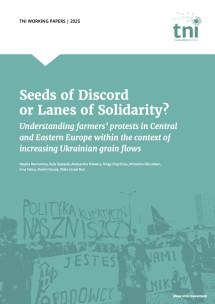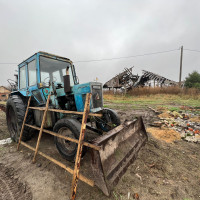Seeds of Discord or Lanes of Solidarity? Understanding farmers’ protests in Central and Eastern Europe within the context of increasing Ukrainian grain flows
Temas
Regiones
The 2023–2025 farmers’ protests in Poland, Romania and Hungary reveal deeper fractures in Central and Eastern Europe’s agri-food systems. Beyond Ukrainian grain, they expose structural injustices, market pressures and political tensions that signal a broader systemic crisis in the region’s agricultural model.

Descargas
Autores
Introduction
Russia’s full-scale invasion of Ukraine in February 2022 and the subsequent blockade of Black Sea ports, through which 90% of Ukraine’s grain had previously been shipped abroad, severely disrupted international food trade, raising global food prices and exacerbating food insecurity in Asia, Africa and the Middle East. To solve the food crisis and help Ukraine export its growing mountains of unshipped grain, the EU and the Ukrainian government launched the “Solidarity Lanes”1 in the late spring of 2022, offering land and river routes to transport Ukrainian grain to Europe for onward shipment to countries in Asia, Africa and the Middle East.
However, much of the Ukrainian grain destined for export to Asia, Africa and the Middle East ended up on the markets of neighbouring EU countries. The flow of (relatively cheap) Ukrainian grain to Central and Eastern Europe (CEE) has become one of the main triggers for large-scale farmers protests in CEE countries. The protests started in spring 2023 and continued until the beginning of 2025. Mobilisations ranged from local sporadic protests to more organised rallies in capital cities and transnational protests on the border with Ukraine. The protesters claimed that the influx of Ukrainian grain was depressing local prices and left local farmers unable to sell their crops.
In response to the farmers’ unrest, the governments of Poland, Slovakia, Bulgaria and Hungary introduced temporary bans on Ukrainian grain in April 2023, which the EU was forced to adopt at European level and keep in force until September 2023. The Ukrainian government filed a complaint with the World Trade Organisation against Hungary, Poland and Slovakia after they banned grain imports from Ukraine for a second time after the EU restrictions were lifted in September 2023. In August 2023, Ukraine launched a new Black Sea corridor for trade vessels heading to and from Ukrainian sea ports despite Russia’s withdrawal from the previous agreement. This allowed Ukrainian grain and oilseeds to be exported via the Black Sea routes. The “Solidarity Lanes”, however, continued to operate. At the time of writing (autumn 2025), about 40% of Ukrainian exports of grain, oilseeds and related products were shipped through the “Solidarity Lanes” and about 60% through the Black Sea.2
The 2023-2025 farmers’ protests in CEE came amid wider discontent by farmers in the EU, who were calling for an end to free trade agreements between the EU and third countries and for more flexible and simplified agricultural and environmental regulations. Although farmers in CEE have also raised similar concerns, their protests became strongly associated with the influx of Ukrainian grain. The protests in CEE have sparked a variety of political and media debates about their nature and consequences. Most of these debates can be linked to one (or more) of the following interpretations: (i) the farmers’ protests were economically unfounded, as Ukrainian agricultural exports did not damage the CEE markets; (ii) the farmers’ protests were aligned with, or orchestrated by, a specific political force; (iii) these protests jeopardised the EU’s solidarity and support for Ukraine.
In this paper we analyse the farmers’ protests in Poland, Romania and Hungary in light of the above criticisms. Agriculture is an important sector of the economy in all three countries. The countries joined the EU in the early 2000s (Poland and Hungary in 2004, Romania in 2007) and since then their economies have benefited significantly from EU membership, including through agricultural subsidies under the EU’s Common Agricultural Policy (CAP). However, subsequent years revealed structural injustices with the distribution of CAP support.3 Although Polish and Romanian agriculture is still dominated by small-scale farms, an intensive process of land accumulation and concentration is underway. Hungarian agriculture meanwhile is characterised by large, industrial monoculture farms backed by oligarchic capital. All three countries are marked by the disappearance of smaller farms, land grabbing, rural depopulation and environmental degradation (see Appendix 1 for further details on the state of agriculture in Poland, Romania and Hungary).
The 2023-2025 farmers’ protests in these three countries differ in terms of intensity, mobilisation, political environment and actors. However, we believe that they all highlight a similar underlying issue - a systemic crisis of the dominant agri-food regime, in which the influx of Ukrainian grain is a trigger rather than a root cause of the crisis.


